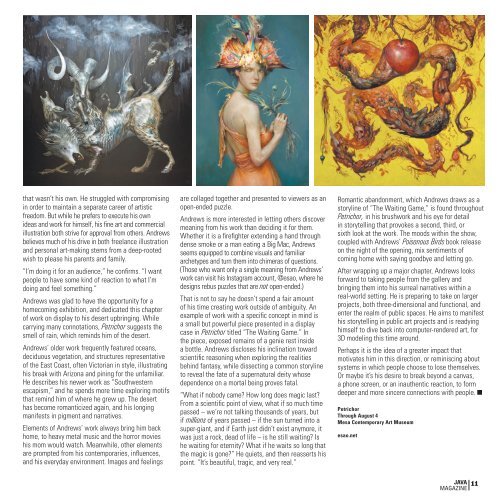JAVA June 2019
Create successful ePaper yourself
Turn your PDF publications into a flip-book with our unique Google optimized e-Paper software.
that wasn’t his own. He struggled with compromising<br />
in order to maintain a separate career of artistic<br />
freedom. But while he prefers to execute his own<br />
ideas and work for himself, his fine art and commercial<br />
illustration both strive for approval from others. Andrews<br />
believes much of his drive in both freelance illustration<br />
and personal art-making stems from a deep-rooted<br />
wish to please his parents and family.<br />
“I’m doing it for an audience,” he confirms. “I want<br />
people to have some kind of reaction to what I’m<br />
doing and feel something.”<br />
Andrews was glad to have the opportunity for a<br />
homecoming exhibition, and dedicated this chapter<br />
of work on display to his desert upbringing. While<br />
carrying many connotations, Petrichor suggests the<br />
smell of rain, which reminds him of the desert.<br />
Andrews’ older work frequently featured oceans,<br />
deciduous vegetation, and structures representative<br />
of the East Coast, often Victorian in style, illustrating<br />
his break with Arizona and pining for the unfamiliar.<br />
He describes his newer work as “Southwestern<br />
escapism,” and he spends more time exploring motifs<br />
that remind him of where he grew up. The desert<br />
has become romanticized again, and his longing<br />
manifests in pigment and narratives.<br />
Elements of Andrews’ work always bring him back<br />
home, to heavy metal music and the horror movies<br />
his mom would watch. Meanwhile, other elements<br />
are prompted from his contemporaries, influences,<br />
and his everyday environment. Images and feelings<br />
are collaged together and presented to viewers as an<br />
open-ended puzzle.<br />
Andrews is more interested in letting others discover<br />
meaning from his work than deciding it for them.<br />
Whether it is a firefighter extending a hand through<br />
dense smoke or a man eating a Big Mac, Andrews<br />
seems equipped to combine visuals and familiar<br />
archetypes and turn them into chimeras of questions.<br />
(Those who want only a single meaning from Andrews’<br />
work can visit his Instagram account, @esao, where he<br />
designs rebus puzzles that are not open-ended.)<br />
That is not to say he doesn’t spend a fair amount<br />
of his time creating work outside of ambiguity. An<br />
example of work with a specific concept in mind is<br />
a small but powerful piece presented in a display<br />
case in Petrichor titled “The Waiting Game.” In<br />
the piece, exposed remains of a genie rest inside<br />
a bottle. Andrews discloses his inclination toward<br />
scientific reasoning when exploring the realities<br />
behind fantasy, while dissecting a common storyline<br />
to reveal the fate of a supernatural deity whose<br />
dependence on a mortal being proves fatal.<br />
“What if nobody came? How long does magic last?<br />
From a scientific point of view, what if so much time<br />
passed – we’re not talking thousands of years, but<br />
if millions of years passed – if the sun turned into a<br />
super-giant, and if Earth just didn’t exist anymore, it<br />
was just a rock, dead of life – is he still waiting? Is<br />
he waiting for eternity? What if he waits so long that<br />
the magic is gone?” He quiets, and then reasserts his<br />
point. “It’s beautiful, tragic, and very real.”<br />
Romantic abandonment, which Andrews draws as a<br />
storyline of “The Waiting Game,” is found throughout<br />
Petrichor, in his brushwork and his eye for detail<br />
in storytelling that provokes a second, third, or<br />
sixth look at the work. The moods within the show,<br />
coupled with Andrews’ Poisonous Birds book release<br />
on the night of the opening, mix sentiments of<br />
coming home with saying goodbye and letting go.<br />
After wrapping up a major chapter, Andrews looks<br />
forward to taking people from the gallery and<br />
bringing them into his surreal narratives within a<br />
real-world setting. He is preparing to take on larger<br />
projects, both three-dimensional and functional, and<br />
enter the realm of public spaces. He aims to manifest<br />
his storytelling in public art projects and is readying<br />
himself to dive back into computer-rendered art, for<br />
3D modeling this time around.<br />
Perhaps it is the idea of a greater impact that<br />
motivates him in this direction, or reminiscing about<br />
systems in which people choose to lose themselves.<br />
Or maybe it’s his desire to break beyond a canvas,<br />
a phone screen, or an inauthentic reaction, to form<br />
deeper and more sincere connections with people.<br />
Petrichor<br />
Through August 4<br />
Mesa Contemporary Art Museum<br />
esao.net<br />
<strong>JAVA</strong> 11<br />
MAGAZINE

















